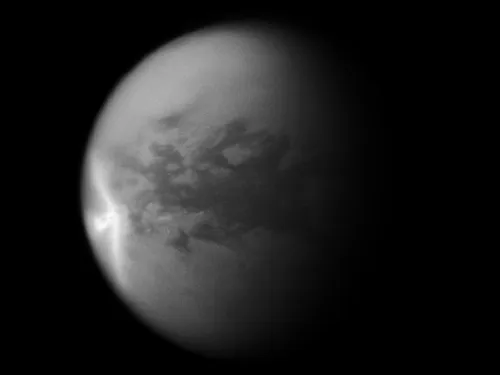
The latest observations of Saturn’s largest moon, Titan, suggest that it’s not just Earth that experiences April showers. Spring also seems to have brought rain to Titan’s equatorial deserts, and on this distant, icy satellite, it rains methane.
The weather patterns were revealed in images captured by NASA's Cassini spacecraft – the first time scientists have seen evidence of rain soaking the moon’s surface.
Belts of precipitation falling from large cloud systems and spotted by Cassini's cameras in late 2010, have apparently darkened the surface of the moon. Scientists interpret this darkening as the areas remaining wet after methane rainstorms.
The observations show that the weather systems of Titan's thick atmosphere and the changes they bring to its surface are affected by the seasons. Scientists working on the Cassini imaging team are amazed to be watching such familiar activity as rainstorms and seasonal changes in weather patterns on a satellite that’s about 1.2 billion km from Earth.
The Saturn system went through equinox – when the Sun lies directly over a planet's equator and seasons change – in August 2009 (a year at Saturn is almost 30 Earth years). Years of Cassini observations suggest that Titan's global atmospheric circulation pattern responds to the changes in solar illumination and is influenced by the atmosphere and the surface.
Cassini found the surface temperature responds more rapidly to sunlight changes than does the thick atmosphere and the changing circulation pattern this brought about produced clouds in Titan's equatorial region.
Clouds on Titan are formed of methane, as part of an Earth-like cycle that uses methane instead of water. On Titan, methane fills lakes on the surface, saturates clouds in the atmosphere, and falls as rain.
Though there is evidence that liquids have flowed on the surface at Titan's equator in the past, liquid hydrocarbons, such as methane and ethane, had only been observed on the surface in lakes at polar latitudes.

The vast expanses of dunes that dominate Titan's equatorial regions need an arid climate. Scientists suspected that clouds might appear at Titan's equatorial latitudes as spring in the northern hemisphere progressed. But they weren’t sure if dry channels previously observed were cut by seasonal rains or remained from an earlier, wetter climate.
An arrow-shaped storm (see picture above) appeared in the equatorial regions on Sept. 27, 2010 -- the equivalent of early April in Titan's "year" -- and a broad band of clouds appeared the next month. Over the next few months, Cassini captured short-lived surface changes visible in images of Titan's surface.
A 500,000km2 region along the southern boundary of Titan's Belet dune field had become darker (see before and after pictures, left). Scientists compared the images to data from other instruments and ruled out other possible causes for the surface changes. They concluded that change in brightness is most likely the result of surface wetting by methane rain.
These observations suggest that recent weather on Titan is similar to the Earth's tropics. In tropical regions, Earth receives its most direct sunlight, creating a band of rising motion and rain clouds that encircle the planet. The methane rainfalls may be the Titan equivalent of what creates Earth's tropical rainforest climates.

